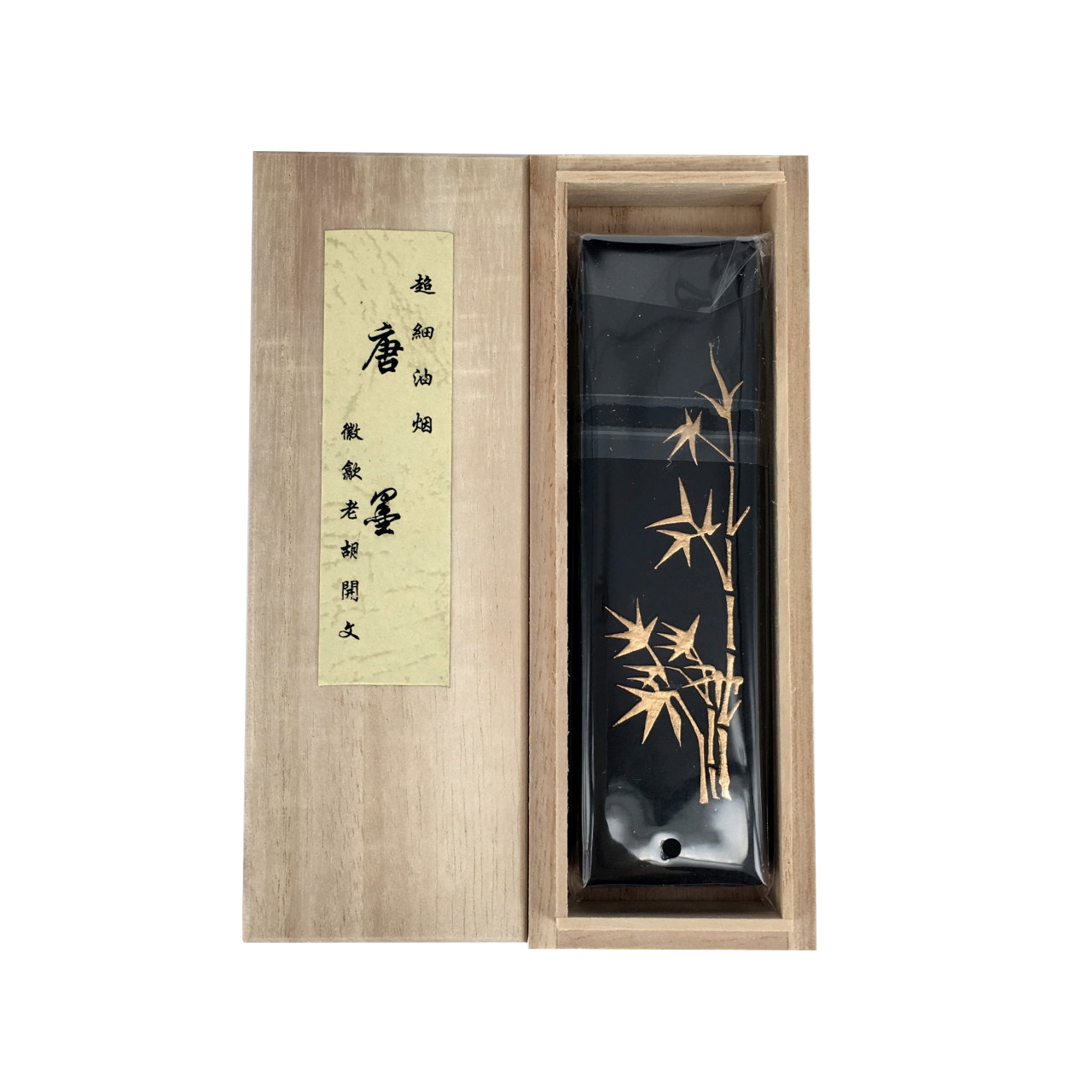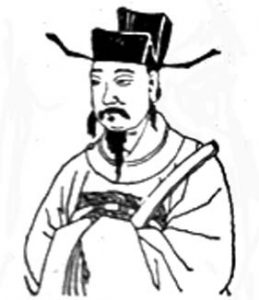
China has over 2000 years history of using and making inksticks. The industry reached its heights in the Ming and Qing Dynasty when methods were most refined and a lot special formulas were devised with different aromatic, medicinal and precious ingredients. The most prestigious representative would be Old Hu Kai Wen which still produces the best inksticks.
Carbon Black from Pine and other Soots
The best inksticks are 90-99% pure fine-ground carbon with only small percentage of resin to bind the inkstick and other ingredients for aroma or special effects.
The first quality inksticks were made from 松烟 pine soot, which produces a rich natural matt dark colour still used today. However, as pine soot became extremely popular in market, the demand for pine exceeded supply resulting in partial deforestation.

In 梦溪笔谈 Dream Pool Essays the Northern Song Dynasty scientist 沈括 Sheng Kuo (1031 – 1095), proposed, possibly for the very first time that inksticks could be made from burning petroleum.
今齐、鲁间松林尽矣,渐至太行、京西、松山大半皆童矣。石油至多,生于地下无穷,不若松木有时而竭 —— 梦溪笔谈
“Nowadays, pines trees are running out in Qi and Lu areas [northeast China and Shandong province]. Even the pine trees in Tai Hang Mountain, west of Beijing are mostly cut down. Only very young and small pine trees are left. However, there is unlimited petroleum which grows under ground. The petroleum supply is endless compared with pine tree supply which is very limited.” – Dream Pool Essays.
So from 11th century onwards, oil soot from petroleum and mixed soots have become popular.
漆烟 Turpentine Glossy Black: Turpentine was first added to pine soot recipes in Song dynasty to make a glossy black finish. Now turpentine soot inksticks are typically 1/3 pine soot and 2/3 oil soot with added turpentine. Variants such as 5 stones turpentine were created with additional precious ingredients for the imperial household.
桐油烟 Tung Oil Glossy Black: is produced from tung oil soot as alternative to pine or petroleum oil which also produces a glossy black result. Tung Oil is a perfect material for inksticks, the oil is very volatile, rich, and transparent. It can make the inkstick very long-lasting.
Historical Inkstick recipes
| Period | Craftsman | Recipe | Resources |
| 三国 Three Kingdoms AD 220 – 280 |
韦诞 Wei Dan | cortex fraxini, egg white, pearl, musk | Qimin Yaoshu 齐民要术 544 C. E. |
| 墨谱法式 Inksticks Index, edited by 李孝美 Li Xiao Mei, Song Dynasty 宋代 | |||
| 南北朝 Northen and Southern Dynasties 420 – 589 |
张永 Zhang Yong | sticky rice, saponin, borneol, musk, cortex fraxini | 文房四谱 Four Treasure of Study, 苏易简 Su Yi Jian, 986 |
| 冀公 Ji Gong | pine soot, syringa, musk, turpentine | 墨谱法式 Inksticks Index, edited by Li Xiao Mei 李孝美, 宋代 Song Dynasty | |
| 唐 Tang Dynasty 618 – 907 |
王君德 Wang Jun De | pomegranate skin, buffalo horn, bluestone | 墨史 Inkstick History, 陆友 Lu You, Yuan Dynasty 元代 |
| cortex fraxini, saponin, bluestone, herba verbenae | 晁氏墨经 Chao Inksticks Index, 晁说之 Chao Shuo Zhi, 宋代 Song Dynasty | ||
| 南唐 Southern Tang 937 – 976 |
李廷珪 Li Ting Gui | buffalo horn, saponin, Gadenia florida, cortex fraxini, sappan wood, white sandalwood, pomegranate skin, fish gelatin, copperas | 墨谱法式 Inksticks Index, edited by Li Xiao Mei 李孝美, 宋代 Song Dynasty |
| gamboge, rhinoceros horn, pearl, croton, etc. | 晁氏墨经 Chao Inksticks Index, 晁说之 Chao Shuo Zhi, 宋代 Song Dynasty | ||
| 宋 Song Dynasty 960 – 1279 |
traditional inksticks | puccoon, cortex fraxini, saponin, sappan wood, buffalo horn, pomegranate skin, indigo naturalis | 墨谱法式 Inksticks Index, edited by Li Xiao Mei 李孝美, 宋代 Song Dynasty |
| cortex fraxini, sappan wood, spikenard, pogostemon, pomegranate skin | |||
| pomegranate skin, cortex fraxini, buffalo horn, golden cypress, gallnut, croton, bluestone, saponin | |||
| hair gel, cortex fraxini | |||
| puccoon, pomegranate skin, cortex fraxini, black fungus, croton, medicine terminalia fruit, indigo naturalis, saponin, pig bile, gamboge, borneol | |||
| oil soot | cortex fraxini, croton, yellow shoots, gardenia florida, nard, holy basil, saponin | ||
| hair gel, cortex fraxini | |||
| puccoon, pomegranate skin, walnut, walnut green husk, medicine terminalia fruit, indigo naturalis, saponin | |||
| puccoon, croton, cortex fraxini, yellow shoots | |||
| puccoon, buffalo horn, pomegranate skin, cortex fraxini, black fungus, medicine terminalia fruit | |||
| sapolin, sticky rice, borneol, musk, cortex fraxini | |||
| 张遇 Zhang Yu | borneol, musk, gold leaf | 窗间记闻 Notes by Window, 马端临 Ma Duan Lin, 宋元 Song – Yuan Dynasty | |
| 叶茂实 Ye Mao Shi | butea gum, cortex fraxini, equisetum hiemale linne, Chinese angelica | 墨史 Inkstick History, Lu You 陆友,元代 Yuan Dynasty | |
| 赵佶 Zhao Ji | styrax, etc. | 墨史 Inkstick History, Lu You 陆友,元代 Yuan Dynasty | |
| 明 Ming Dynasty 1368 – 1644 |
沈继孙 Shen Ji Sun | sappan wood, rhizoma coptidis, cortex erythrinae, almond, puccoon, sandalwood, jasmine, radix angelica, momordic benevolence | 墨法集要 Inksticks Craftsmanship, 沈继孙 Shen Ji Sun, 1775 |
| 方瑞生 Fang Rui Shen | pig bile, borneol, musk, rhubard, sappan wood, galangal, spikenard, asarum, clove, pogostemon, holy basil, hysimachia sikokiana, peony | 墨海 Inkstick Ocean, 方瑞生 Fang Rui Shen, 明代 Ming Dynasty | |
| cortex fraxini, croton, yellow shoots, gardenia florida, spikenard, pogostemon, holy basil, saponin | |||
| 清 Qing Dynasty 1644 – 1912 |
谢崧岱 Xie Song Dai | sappan wood, croton, rice wine | 南学制墨札记 Inksticks Craftsmanship Notes, 谢崧岱 Xie Song Dai, 1849 – 1898 |
| 内务府墨作则例 Imperial Palace Household Department |
puccoon, turpentine, white sandalwood, holy basil, lysimachia sikokiana, pig bile, borneol, pogostemon, sticky rice wine, guangton glue | 三草墨 San Cao Royal Inksticks, Imperial Palace Household Department, 清代 Qing Dynasty | |
| sappan wood, turpentine, puccoon, lysimachia sikokiana, white sandalwood, holy basil, bear bile, borneol, pogotemon, sticky rice wine, guangton glue | 独草墨 Du Cao Royal Inksticks, Imperial Palace Household Department, 清代 Qing Dynasty |

[…] the History of Inkstick recipes and the Buyer’s Guide for more information on the different […]
[…] Read more about the history of inkstick recipes. […]
[…] les recettes Historique des inkstick (en anglais) et le Guide de l’acheteur pour plus d’informations sur les différents types, et pour […]
It’s amazing to see how long Chinese people have been using Ink Sticks.
[…] Read more about the history of inkstick recipes (anglais). […]